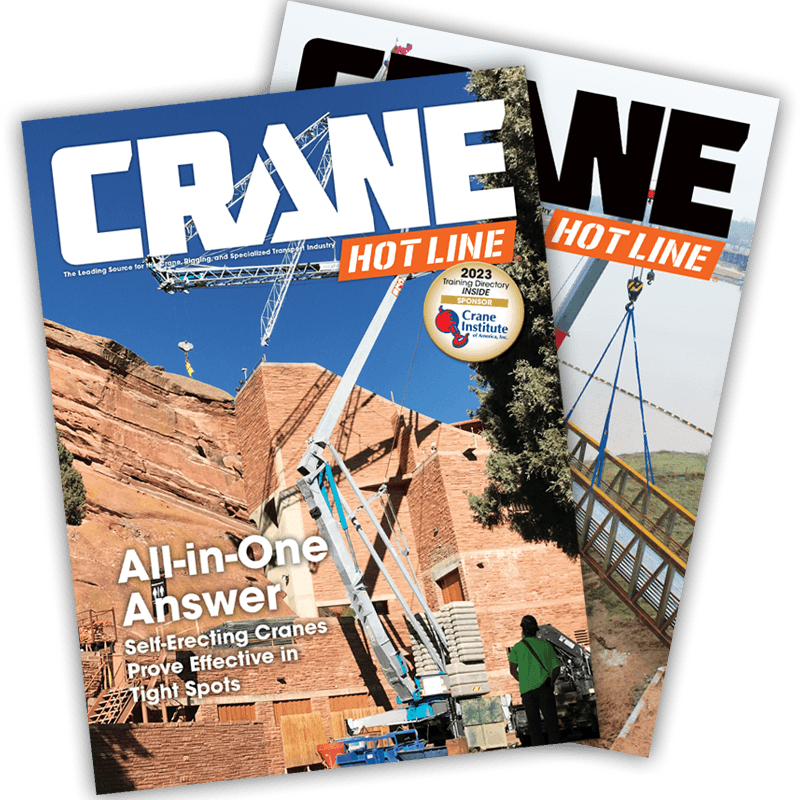SC&RA Hauling Job of the Year Awards Presented
May 12, 2016 - SC&RA announced the winners of the Hauling Job of the Year Awards during the association’s Annual Conference, April 26-30, at the Hilton Orlando Bonnet Creek, Orlando. The Hauling Jobs of the Year competition recognized three hauling projects that epitomized how SC&RA members successfully meet professional challenges in hauling. Winners were recognized for shipment routing; planning; overcoming physical elements; safety considerations; and execution.
The awards went to Berard Transportation, New Iberia, La., in the Moving (using specialized equipment such as self-propelled transporters, dollies and crawler assemblies) category; Intermountain Rigging & Heavy Hauling, Salt Lake City, in the Hauling Over 160,000 Pounds (net) category; and Emmert International, Clackamas, Ore., in the Hauling Under 160,000 Pounds (net) category.
Berard moved a 1,300-ton cold box, measuring 103 ft. long x 48 ft. wide x 122 ft. high, a distance of 195 mi. in Louisiana. Due to draft restrictions at the fabrication port, the cargo needed to be loaded onto a shallow draft barge, transferred to a deep-water port, and then again transferred to an ocean-going ship. The Berard team selected Port Fourchon, a nearby oilfield service port not traditionally used as a deep-water shipping port. Much of the lengthy barge journey from the fabricator’s plant in New Iberia crossed unprotected offshore waters. Berard also provided all the equipment for the land transport, including 80 axle lines of Scheuerle Self-Propelled Modular Transporters (SPMTs), barge ramps, ballast pumps, mooring equipment and grillage.
The lengthy list of challenges met included: loading-out the massive shipment at a shallow port; meeting stringent securing and sea state criteria; maintaining stringent equipment maintenance and inspection records; load testing the mooring trucks and testing other equipment; and developing and following emergency action plans for every aspect of movement. There were no incidents, injuries, or even questionable procedures whatsoever during the entire execution of project, which occurred over a two-week period in December 2015.
Intermountain Rigging & Heavy Haul (IRH) delivered two transformers from a rail siding in Thoreau, N.M., through Arizona and to a substation in Monticello, Utah. One transformer weighed 762,800 lbs. and measured 44’7” long x 12’11” wide x 12’8” high. The other weighed 725,320 lbs. and measured 35’5” long x 12’10” wide x 16’1” high. The project also included moving a throat section that weighed 95,900 lbs. and measured 17’4” long x 12’8” wide x 11’9” high, as well as 33 accessory parts, from Houston to Monticello.
The gross weight of the heaviest load tipped the scales at 1.8 million lbs. At some locations, as many as nine trucks were attached to the load. The project necessitated intermittent plating of roads and significant road work to gain access to the rail siding and the permit substation. The route passed through Bureau of Indian Affairs territory at two locations and across a long bridge spanning the San Juan River, through wintry conditions of mud, snow, wind, and very cold temperatures.
Emmert International hauled a 115,613-lb. FTO vessel with a length of 35’6” and a girth of 28’ from Moss Point, Miss. to Mont Belvieu, Texas. Accompanying the load was the FTO’s detached stack section. It had a 90° elbow and was 34’9” long, 15’4” wide, and 9’5” high, and weighed 34,000 lbs. with an off-set center of gravity.
Emmert determined a route involving both water and land travel would save time and money. However, the final over-the-road portion to the plant would remain extremely demanding regardless of planning. Complicating the 20-mile, nighttime route to the plant were narrow roads and uneven and sloping ground conditions. Many overhead power and utility lines were raised or removed, and the load had to be maneuvered past low overpasses, toll booths, and railroad crossings. Emmert coordinated six bucket trucks to handle traffic lights; three bucket trucks for miscellaneous tasks; six bucket trucks from the power company; and six bucket trucks for cable TV and phone lines. Ten police escorts assisted with traffic control and passenger vehicle safety. High pole vehicle, escorts, and Emmert crews rounded out the convoy.
The other entries included:
Daco Heavy Lift de Centroamerica S.A. transported seven Vestas V112 wind turbines from the port of Puerto Quetzal in Guatemala to the Viento Blanc Wind Farm at the town of Los Rios. The route covered more than 50 miles, mostly via highway. However, more than six miles of the route presented serious logistical challenges due to a winding road with extreme tight turns, heading up a mountain towards an active volcano with inclines of up to 13%.
Emmert transported a 380,000-lb. vessel, measuring 65’8” long x 18’7” wide x 17’9” high, from Quebec, Canada, to Utah. Challenges faced along the 1,775-mile route included tight clearances, steep grades, tight turns and inclement weather. Emmert accomplished this move with a THP/CA 14-line transport system.
Barnhart transported two combustion turbines and two combustion generators from Savannah, Ga. to Rising Sun, Md. Barnhart first rolled them onto a barge for transport to Port Deposit, Md. Once in Port Deposit, the company rolled them off of the barge and transloaded them to the Barnhart GS800 before transporting them the final 25 miles. The project began in June 2015 and was completed in August 2015.
Edwards Moving & Rigging Inc. transported a 166,478-lb. cold box, measuring 55’4” long x 18’ wide x 23’2” high and a 327,268-lb. demethanizer reflux drum measuring 203’ long x 12’10” wide x 14’ 1” high. The components traveled via separate routes over 100 miles each from the Port of Caddo-Bossier just south of Shreveport, La. to the Eastman Chemical Company in Longview, Texas.
Emmert transported a 307,162-lb. bullet tank, measuring 233’10” long x 18’ wide x 19’6” high, from Texas to North Dakota. Along the 2,150-mile route, Emmert overcame a difficult railroad crossing; overhead wires; the need to travel opposite the normal direction on one-way streets; tight turns; steep grades; and rain. The tank traveled aboard a Goldhofer THP/CA 14-line split with hydraulic turntables.
Energy Transportation, Inc. relocated a drag line consisting of nine loads to the Caballo Rojo Coal Mine near Gillette, Wyo., from June 4 to August 1, 2015. The two largest loads each traveled with a gross vehicle weight of 2,173,600 lbs. with overall dimensions of 296’7” long, 19’8“ wide, and 15’6” high.
Fagioli transported four engines weighing 256 tons each from Ghana to Niger in eight months. Total distance traveled exceeded 7,500 miles. Fagioli characterized the job as one of its most demanding ever because of weak infrastructure that necessitated bridge and road repair and construction by the company; inclement weather that included high temperatures, heavy rains, and river flooding; and the sort of challenge no company normally plans for—a coup d’etat in Burkina Faso.
Tradelossa transported two 415-ton reactors, in separate convoys, from the Port of Altamira to Cadereyta Nuevo Leon in Mexico. The reactors were approximately 93.5’ long, 24’ wide, and 17’ high. The job took place from October to December 2015 and involved a route of 383 miles.
Transdata Movimentação de Cargas Complexas safely transported one of the world’s largest rotors on a 373-mile route in Brazil, ending at the Belo Monte Hydoelectic Plant. Ninety percent of the movement of the 348-ton rotor took place at night on a configuration measuring 354’ long x 28’ wide x 28’ high.
Fagioli transported a 70-ton transformer measuring 24’7” long x 9’6” wide x 12’2” high on a route winding than 100 miles on slopes of up to 12° through the Italian mountains. Particularly challenging was an uphill tunnel that included a loop.


